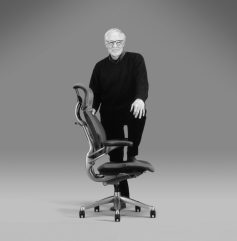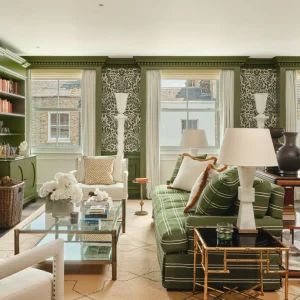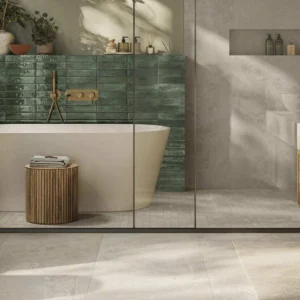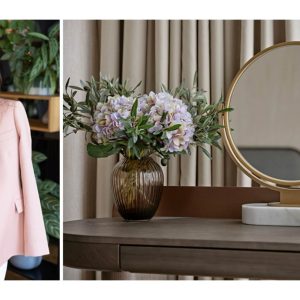
Words by Emily martin
HUMANSCALE MARKS 25 YEARS of its iconic Freedom Chair, designed by legendary designer Niels Diffrient. A milestone in ergonomic innovation, Freedom transformed the task seating landscape with its innovative approach to user comfort and timeless aesthetic, and remains as relevant today. Unlike other chairs that require extensive instruction manuals to operate, Freedom makes ergonomics intuitive and effortless, allowing people to move naturally and instinctively throughout their day. Diffrient, often labelled as the ‘father of ergonomics’, recognised that traditional office chairs restricted natural movement, keeping users locked in place. I spoke to Bob King, founder and CEO of Humanscale, about Freedom’s design and working with Diffrient to bring a chair to market, which would change both officer workers’ lives, as well as his own life, forever.
 The Freedom Chair – with its designer Niels Diffrient – was a milestone in ergonomic innovation
The Freedom Chair – with its designer Niels Diffrient – was a milestone in ergonomic innovation
Tell me about first meeting Niels Diffrient – how and when did you meet him and what was your first impression of him?
It was an amazing experience for me. I met Niels, for the first time, in January of 1997. And what was interesting was the lead up to that, more than the meeting. Back in 1980, I started Humanscale with the idea of making ergonomic tools – tools that will allow you to adjust your [work] stuff to your body. I noticed that people were hunched over their desk all the time, even if they had a monitor arm or something like that. They were hunched forward, and even today, if you look at how people work, they’re leaning forward on their desk. And that’s an unhealthy way to work. I realised that chairs were keeping people in this position because they were they were stuck in one [locked] position. You can’t sit in one position very long, as you get tired and lean forward and put your weight on your forearms and so on. I figured this was really interesting – we should come up with a chair that’s easy to use. And if we had a chair that was easy to use – whatever that meant – people would move from one position to another; they’d grab a telephone and lean back, grab a document, lean back, and look at it, sit up a bit, lean back again, and move all day from one position to another and not get tired of being stuck in one posture. I interviewed – oh, I don’t know – a dozen or so designers, but none had thought about this problem or had a solution at all. Then someone told me ‘you should talk to Niels different. He’s maybe the greatest living chair designer.’ I called him up… and I told him about the problem. I told him the chairs were too complex and that was causing a huge problem in terms of health – people are putting themselves in really awkward postures in order to work and that it would be important to have a chair that was easy to use, and [asked] would he be interested in talking to us about that. And he was sceptical because we were small, but he agreed to see me. I got up [to Ridgefield, Connecticut, from Manhattan] and he was charming; he was brilliant. He understood design on another level from myself, obviously, and we talked for a couple hours. I told him that [Humanscale] had a history of making things simple: we had designed a keyboard support that you put where you wanted and it stayed there – you didn’t have to tighten any knobs; monitor arms where you could adjust with one hand, and so on. And I said: ‘We think that the world needs a chair, that’s easy to use as well.’ And inally, I said: ‘Niels, what do you think? Would you want to work with us?’ And he said: ‘Well, you know, why don’t I give you a tour of my studio?’ He didn’t say ‘yes’. I think he wasn’t quite sure of me, but he gave me a tour of the studio and he took me to his prototype shop and in the prototype shop he had prototype of what became our Freedom Chair.

What was your first opinion of the Freedom Chair when you saw it, conceptually?
I said: ‘Geez, Niels, this is interesting. What is going on here?’ And he said ‘sit in it, Bob, and see if you can figure out how to lean back’. And so, I sat in it and, of course, at that point, I was quite an expert on chairs. I always try to figure out how to lean back in a chair. Even today I take my fingers to the front of the seat pad, underneath the seat, and I move them rearward to try to feel for a reine lock or tilt limiter. He laughed and said: ‘Bob, forget that. Just lean back.’ And so I just leaned back and it held me up. I leaned back some more and it held me up. I sat up and it held me up and I said: ‘Niels, what’s going on here? Where’s the tilt limiter? Where’s the recline lock?’ And I looked under the chair and there wasn’t [either]. There wasn’t a spring. There’s a spring under every [task] chair and a mechanism to control the spring. He said:
‘I got rid of that whole thing. I got rid of the whole mechanism that’s under every chair and I replaced it with one thing. I replaced it with the weight of whoever happens to sit on the chair at any given time.’ That’s pretty clever; that means 1,000 people come to work, 1,000 people sit in chairs, perfectly adjusted for them, so they can just grab the phone and naturally lean back and not have to think about it, not have to go to chair training and not have to do the chair training webinar and so on.
 Politicians are big fans of the design
Politicians are big fans of the design
Can you explain the mechanics of how the Freedom Chair works?
Fundamentally every [task] chair has a spring under it that creates a recline force on the backrest. You need to adjust that spring with the knobs to make it a little softer or whatever and, essentially, you must lock it as it’ll either hold you all the way up or hold you somewhere in the recline, but it won’t allow you to go from one position to another. Niels eliminated the spring, and that whole mechanism, and replaced it with the weight of the sitter. [The Freedom Chair] transfers a percentage of the weight to the backrest to create force and so it’s the exact right amount of force throughout the recline whoever sits in the chair. [There are] synchronous armrests, which you can adjust with a single hand. The headrest automatically moves into place when you lean back.
 Politicians are big fans of the design
Politicians are big fans of the design
What was the reaction when it was first launched to market in 1999?
People loved the concept. I mean, everyone, literally, everyone we spoke to because no-one knew how to adjust their damn chair, so it was well embraced. We won pretty much every major design award. That was when Steelcase introduced their latest flagship chair called the Leapshire at Neocon in 1999. A magazine wrote an article comparing the two chairs and they said, with all the knobs and levers and controls, [the Leapshire] is kind of like a machine and the Freedom Chair just works with your body and is kind of like an organism. And it was very exciting. And the Freedom Chair looks as relevant today as it as it ever did.
And 25 years later, is still as popular?
It sells better today. In fact, I have a list of famous people sitting in the Freedom Chair today!
What do you think makes it so revolutionary?
What made it revolutionary, of course was, [the design]. I’ve asked hundreds of people – I do it just for fun now – I ask: ‘Hey, what kind of chair is that you’re sitting in?’ And they’ll say: ‘Oh, I don’t know.’ And then after that, I ask another question, which is: ‘I’m curious, how do you lean back in that chair?’ And everyone gives me the same answer about levers under here, I have the instructions in the draw somewhere. Few people know how to lean back, and the data supports this: Cornell and Virginia Tech both did studies on this and found that around 6% or so roughly of office workers knew how to lean back in their chair. I personally think it’s below 2%. But that was the main thing [for the Freedom Chair], allowing people to move from one position to another… almost effortlessly. That’s never been done before.
Has the design changed much over the years?
The way Neil’s designed things – and in a way he was the last of the mid-century modernists – was very different to the way things are designed today. Today, people design things to look as beautiful as possible and modern, and it’s done on a computer. The mid-century modernist didn’t believe that because, in the US and Canada, they all went to Cranbrook Academy in Michigan, which was the US answer to the Bauhaus, and were taught to solve a functional problem as simply, minimally and elegantly as they could. You end up with something that’s not just beautiful, but timeless because the form lowed from the function and not from society’s sense of beauty at the time. The Freedom Chair looks as relevant today as it ever did. We make little things better: we make the arms adjust more smoothly by changing the gear ratios; we change the material so it’s tougher. I’ve been a conservationist since I was a kid, and I’ve worked for the World Wildlife Fund for 35 years, so I’m very focused on that, and we’re the first company to actually use reclaimed fishing nets to make chairs. So, we keep getting it better and better and more and more sustainable.
Is it fair to say that Niels Diff rient influenced Humanscale’s success for the better?
Oh, without a doubt. The Freedom Chair kind of became our brand. We stood for simplicity, function, sustainability – which was what that chair was – and always believed in [that], but I think we got the attention with the Freedom Chair that we didn’t have making ergonomic products. We were the leader in making monitor arms, keyboard supports and task lights, but those aren’t so sexy. So, we didn’t get the attention that we got with the Freedom Chair.





